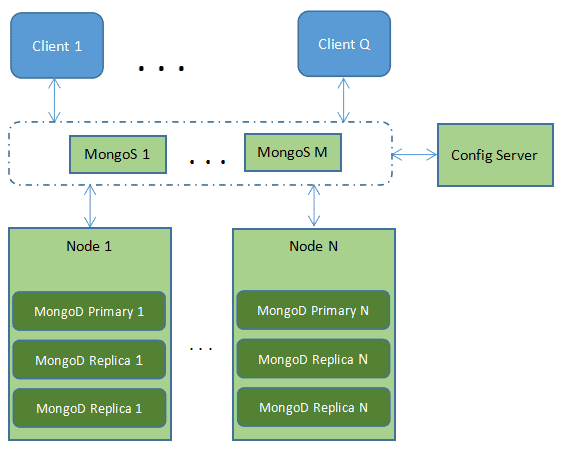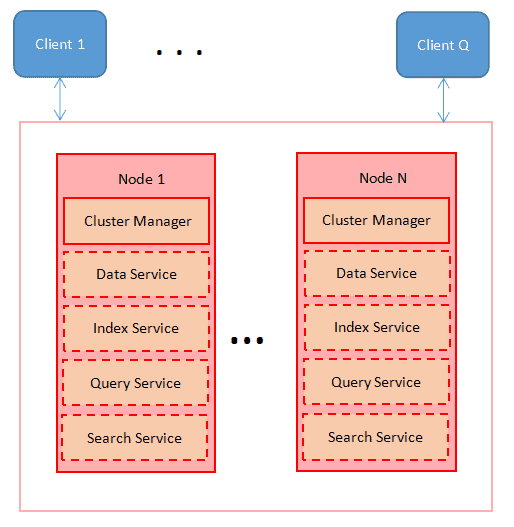1. 概述
本文将深入对比两款主流 NoSQL 数据库:MongoDB 和 Couchbase。我们将从架构设计、核心特性、数据模型、查询语言以及分区策略等关键维度展开分析,帮助开发者根据实际场景做出合理选型。
2. NoSQL 数据库简介
SQL 数据库自 1970 年代起长期占据主导地位,其设计初衷之一是减少数据冗余——毕竟当年存储成本高昂。SQL 数据库的水平扩展需要大量运维工作,通常只能通过升级服务器硬件实现垂直扩展。
NoSQL(Not Only SQL)数据库在 2000 年代末兴起,解决了水平扩展难题。 随着算力成本持续下降,我们得以将数据分散到多台普通服务器上。NoSQL 采用文档(通常是 JSON 格式)存储数据,摒弃了 SQL 数据库严格的表结构约束。
MongoDB 是早期 NoSQL 代表,凭借简单部署和易用性长期领跑。而 Couchbase 等新势力则凭借出色的扩展性和高性能表现异军突起。
3. 架构设计
先看 MongoDB 的部署架构:

每个节点包含一个副本集(1 个主节点 + 2 个从节点)。每个副本集运行独立的 MongoD 服务,负责数据、索引和查询管理。MongoS 组件则充当分布式查询路由器和处理器。
再看 Couchbase 的部署架构:

每个 Couchbase 节点必须运行 Cluster Manager 服务,其他服务组件(Data/Index/Query/Search)可按需部署。Couchbase 通过自动哈希机制将数据分片到不同节点的 Bucket 中。
无需配置服务器——元数据管理已内置在数据库设计中。扩展集群只需添加新节点,简单粗暴。
4. 特性对比
核心特性对比一览表:
| 特性 | MongoDB | Couchbase |
|---|---|---|
| 存储格式 | 二进制 JSON (BSON) | 标准 JSON |
| 查询语言 | 专有查询语言 | N1QL(类 SQL 语法) |
| 分区策略 | 手动分片 | 自动哈希分区 |
| 事务支持 | 4.2+ 版本支持分布式事务 | 6.6+ 版本支持分布式事务 |
| 全文搜索 | 4.0+ 版本支持文本搜索 | 6.0+ 版本支持全文搜索 |
5. 数据模型
与 SQL 数据库不同,NoSQL 不强制数据模型。文档无需遵循统一结构,开发者可自由设计实体关系。实体关系建模方式:
- 一对一(1-1):默认将一个实体嵌入另一个实体(MongoDB 和 Couchbase 均支持)。也可存储实体 ID 引用。
- 一对多(1-N):在主实体中嵌入 N 个实体数组或 N 个实体 ID 数组(两者均支持)。
- 多对多(M-N):在 M 个实体中各嵌入 N 个实体数组或 N 个实体 ID 数组(两者均支持)。
⚠️ 嵌入实体还是 ID?选择哪种嵌入方式?这些设计决策需结合应用实际访问模式谨慎权衡。
6. 数据查询
MongoDB 使用专有查询语言,Couchbase 则采用类 SQL 的 N1QL。以 STUDENT 集合为例,对比基本操作:
6.1. 查询操作
-- SQL
SELECT * FROM STUDENT WHERE name = 'Ryan';
-- MongoDB 查询语言
db.STUDENT.find({name:"Ryan"})
-- Couchbase N1QL
SELECT * FROM STUDENT WHERE name = 'Ryan';
6.2. 插入操作
-- SQL
INSERT INTO STUDENT(id, name) VALUES (123, 'Ryan');
-- MongoDB 查询语言
db.STUDENT.save({_id: "123", {"id": "123", "name": "Ryan"})
-- Couchbase N1QL
INSERT INTO STUDENT(KEY, VALUE) VALUES ('123', {"id": "123", "name": "Ryan"})
6.3. 更新操作
-- SQL
UPDATE STUDENT SET name='John' WHERE id = 123;
-- MongoDB 查询语言
db.STUDENT.update({_id: "123"}, {"name": "John"})
-- Couchbase N1QL
UPDATE STUDENT SET name = "John" WHERE id = "123"
6.4. 删除操作
-- SQL
DELETE FROM STUDENT WHERE id = 123;
-- MongoDB 查询语言
db.STUDENT.remove({_id: "123"})
-- Couchbase N1QL
DELETE FROM CUSTOMER WHERE id = "123";
✅ 深入学习 MongoDB 查询可参考 Spring Data MongoDB 教程
✅ Couchbase 文档持久化详见 Spring Data Couchbase 教程
7. 分区策略
分区是 NoSQL 数据库的核心能力,两者实现方式差异显著:
MongoDB
默认不分区,数据集中存储在单节点。通过分片(Sharding)实现水平扩展,将数据拆分为子集分布到不同节点。配置服务器(Config Server)管理集群元数据。Couchbase
*无需配置服务器**。每个节点自带 Cluster Manager 服务,可灵活部署 Data/Index/Query/Search 服务。这种设计允许按需分配计算资源,实现真正的弹性扩展。
8. 总结
通过本文分析,我们梳理了 MongoDB 与 Couchbase 的核心异同:
✅ MongoDB 是 NoSQL 入门首选:社区生态成熟,MongoDB University 提供丰富学习资源,适合快速上手。
✅ Couchbase 兼顾 SQL 习惯与高性能:类 SQL 的 N1QL 降低学习成本,自动分区和内存优先架构带来出色扩展性,适合对性能要求严苛的场景。
选型建议:
- 优先开发效率 → MongoDB
- 优先扩展性与查询灵活性 → Couchbase
- 需要强事务支持 → 两者均需 4.2+/6.6+ 版本